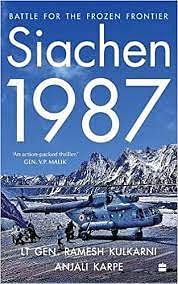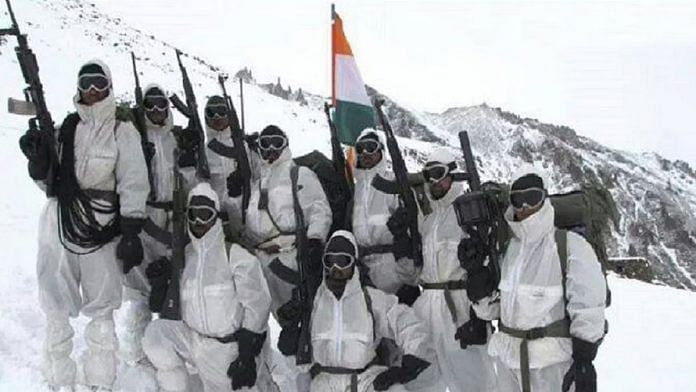Boys,’ I began, ‘I understand. I understand that this mission is a question of life and death – but forty men depend on you and those forty men will freeze to death at these posts without you.’ Those twelve pairs of eyes bored into mine and twelve young men listened intently as I continued, ‘I also understand the risk for all of you if you undertake these sorties.’ Easy when it is said in a single line, but I could feel the piercing gazes questioning me silently: ‘You want us to fly there, knowing possible death awaits us?’ As if in answer to that unspoken question and having taken that crucial call, I heard myself say, ‘I have weighed all the factors and I want you to undertake this mission. I will instruct the 105 mm guns and the mortars to keep firing on the Pakistani post to cover you, to the extent they can. Machine-gun fire from Amar will also help in keeping the Pakistani heads down. And yes – best of luck to you!’
The briefing ended with Tom Dullat taking the lead by getting into his own chopper and nominating three more for the mission. The two words he uttered ring in my ears even today: ‘Jo hukam.’ That calm statement indicated that my word was their command. Those two words reassured not just Chandan and me, but also the young, anxious pilots who would be risking their lives for this mission. That scene comes back to me very often and I think of those twelve pairs of eyes looking at me unflinchingly as I made my decision. We were standing together, as one collective group, but the decision had been mine. The life-threatening plan of action had no guarantee of success, but then again, I could see no alternative to the certain death of our troops at Amar and Sonam.
At such moments, the commander simply has to take a call, weighing human lives and believing that everyone would survive, yet with the full awareness that wishful thinking would ensure neither success nor survival. Once the decision was taken and instructions began to be relayed all over, I was overcome with something that all leaders go through: the burden of a decision that can spell life or death for a person.
It is a burden that must be shouldered and it is a very lonely moment. The enormity of this has no parallel because it needs to be taken in spite of the wave of uncertainty that assaults your functioning. What served as a psychological prop for the decision and this operation was Tom Dullat’s parting statement – ‘Inshaallah, hum vaapis ayenge!’ (God willing, we will return!) – as they got ready for their mission. The roar of four Cheetah helicopters revving up to take off filled the air; the thundering sound was nothing short of a battle cry. Loaded with the minimum of provisions for the survival of Amar and Sonam, they took off from the base camp.
I squinted as I followed their path towards the two posts. Now it was just a question of waiting… and waiting. I had to inform the army commander about the decision taken, about launching those helicopters for replenishment of the Amar and Sonam Posts. Detailing the brief plan, I also spoke about the considerable risk involved and the wait for their return being inevitable to know the results of the mission. Being the first visit of the army commander, he must have surely wondered how this decision was made in the nick of time and about the priorities accorded to numerous plans. It was also the best introduction he could have had to the way things operated in this sector, where grave situations demanded thinking on our feet and what was expected from individuals could suddenly alter, based on the way things panned out.
Also Read: How India beat Pakistan to gain control of the world’s highest battlefield 34 years ago
My mind that day was entirely focused on the fate of the four Cheetahs. As with every crisis that had to be managed, all I could do once the plans were made and decisions taken was to wait – and that wait was killing. I sometimes felt it would have been easier to be part of those missions, having things directly in my control. But that is not a ‘luxury’ a division commander can afford. I realized it would be best for us to head to the Battalion HQ at Kumar in the two remaining choppers so I suggested we leave the base camp and relocate there. I knew the army commander needed to be briefed about other issues as well, but at this moment I was too wired up to focus on general matters.
The flight path of the helicopters was visible up to a certain point from Kumar and I willed myself to look beyond, far into the distance hidden by more mountain ranges, imagining the onward route taken by the pilots, with my ears sharply tuned to hear of their safe return instead of a crash. That circuit from base camp to the two posts, unloading and then back up in the air, seemed far beyond our control. Time stretched and so did my nerves. What would the final outcome be?
The half-hour that passed was beyond agonizing, and just as I felt I could take it no longer I heard a faint sound at the same time that I saw the first black speck appear in the distance. As the speck grew bigger, the relief as I counted another three such specks, appearing one after the other, was immeasurable. The breath that I released and the instinctive desire to shout out loud was hard to contain. All four helicopters were on their way back and that meant only one thing. The daring trip had been a success!
 This excerpt from Lt Gen Ramesh Kulkarni and Anjali Karpe’s ‘Siachen 1987: Battle for the Frozen Frontier’ has been published with permission from Harper Collins India.
This excerpt from Lt Gen Ramesh Kulkarni and Anjali Karpe’s ‘Siachen 1987: Battle for the Frozen Frontier’ has been published with permission from Harper Collins India.



